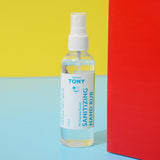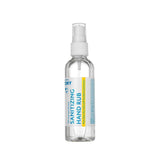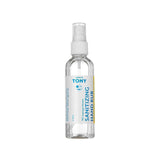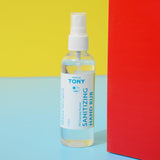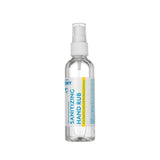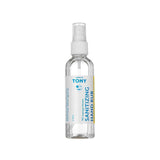Hand Sanitizer Gel
Uncle Tony Sanitizing Hand Rub is a mixture of 70% isopropyl alcohol, aloe vera extracts and neem extracts that removes bacteria and germs from your hands and keeps them safe. This sanitizing hand rub, with sandalwood fragrance, leaves your hand soft and clean, avoiding any sort of dryness SHELF LIFE (months): 23
- Sanitizing Hand Rub
- 70% Isoprophyl Alcohol
- Aloe vera extracts and neem extracts that removes bacteria and germs from your hands
Place a coin sized amount on the palm and rub onto hands and fingers briskly until dry.
FAQ
Q. 1 What is sanitizing hand rub, and how does it differ from regular hand sanitizer?
The need for hand hygiene cannot be overstated, especially during the COVID-19 pandemic. One of the most important tools in maintaining hand hygiene and preventing the spread of germs and infections is sanitizing hand rub or commonly referred to as hand sanitizer. It is also very beneficial when there are no soap and water at hand. Though the phrases "sanitizing hand rub" and “hand sanitizer” are used as synonyms, they describe one product.
Hand sanitizers are usually defined in the form of a gel, liquid or foam-based substance which comprises of ethanol as an active ingredient. The main objective of the hand sanitizer liquid is to get rid of or deactivate pathogenic microorganisms such as bacteria and viruses on skin when used correctly.
- Alcohol Content: It is for this reason that hand sanitizers are rich in high alcohol content, a minimum of 60% to 70%, which eliminates many sorts of microbes.
- Quick Drying: Application of hand sanitizers wipes out within minutes drying the skin leaving it in a clean state.
- Portability: Hand sanitizers come in different sizes including open pouches and portable pocket size bottles, that can be used anywhere.
- Convenience: The application of this hand hygienic product is simple and does not need water or towels, which makes it convenient in places where there are no facilities to wash hands.
In conclusion, hand sanitizer for sensitive skin can be defined as a chemical that is used to disinfect hands by either killing or rendering inactive microorganisms. Its main difference from the regular practices of handwashing is that it is convenient and portable, becoming an important tool which enables one to keep clean hands whenever soap and water are missing. The fact remains that not all best hand sanitizer is the same, and customers should be sure to use products containing enough alcohol content handy to kill microorganisms.
Q. 2 How do I use hand sanitizer properly?
Appropriate application of hand sanitizers is important for its to work in eliminating germs and curbing the spread of diseases.
- Check the Alcohol Content: Make sure that the hand sanitizer you are using contains at least 60% – 70% of alcohol like ethanol or isopropyl alcohol. This is an alcoholic concentration that can kill many microorganisms.
- Clean Hands: Ensure that your hands are not visibly dirty or covered in dirt before using the hand sanitizer. As opposed to this, hand sanitizer is a product which is made in such a way that it provides for the killing of germs but applies well only if used on dry hands.
- Dispense an Appropriate Amount: Apply enough hand sanitizer from your palm to cover all surfaces of the hands. A dime-sized amount will do most of the time, but if your hands are bigger, you may need more.
- Rub Hands Together: Rub your hands strongly so that all the surfaces must be ensured including top and bottom of hand, finger bases and toenails. Rub for not less than 20 seconds, when hands are dry.
- Avoid Touching Surfaces: When hand sanitizer for sensitive skin is wet in your hands, you should not touch any surface or object because this can pass the same germs back to your hands.
- Allow Hands to Dry: There are a number of hand sanitizers that usually quickly evaporate and ultimately leave your hands dry. Do not wipe your hands with a cloth or towel, as this will diminish the effectiveness of sanitizer.
- Reapply as Needed: Apply the best hand sanitizer as frequently as necessary, particularly in instances where no soap or water is available and after directly contacting surfaces inside of public settings. Be regular in use, especially during winter and flu sickness or when communicable illnesses spread.
When it comes to maintaining adequate health, proper hand hygiene is an important factor in keeping germs from being transmitted. Although sanitizing hand rub is certainly handy, it should not be used to replace soap and water if these commodities are present. No matter how hard germs are clinging on to your hands, handwashing can effectively flush them away. Read the benefits of Hand Sanitizer.
Q. 3 Is hand sanitizer safe for children?
There is a high level of security as well with the use of sanitizing hand rub; however, in order to protect themselves against such drug-related deaths, children should be supervised while using this hand cleaner. It is crucial that one takes caution in using the sanitizer, especially for smaller children, to reduce the possibility of ingestion and skin irritation.
- Adult Supervision: Adults should always make sure children use hand sanitizers at all times. Adults have a duty of ensuring proper application using the sanitizer and monitoring to prevent misuse.
- Age-Appropriate Use: Hand sanitizer should not be administered to infants or very young children unable to refrain from inserting their hands into their mouths. On the contrary, for children below 2 years old, keep special stress on regular handwashing with ordinary soap and water.
- Teach Proper Application: Talk about how older children should use the best hand sanitizer to and point out why all areas of the hands should be covered by the alcohol mixture before handling anything else.
- Store Safely: When not using the hand sanitizer for sensitive skin, it has to be kept away from children. The high alcohol content may be fatal when consumed. Store it in a safe place, and if child-resistant packaging is available use to store the product.
- Supervise Application: Children older than even two years may be enticed to take large quantities. Make sure they apply a reasonable quantity and do not overdo it during the whole day.
- Avoid Scented or Flavored Varieties: The flavored or scented variety of hand sanitizers poses even a higher risk of being licked by the children. Better to stay with unscented and flavorless variants.
- Monitor for Skin Irritation: Children can be sensitive to harsh skin and alcohol in hand sanitizer may make them irritated. If you experience any skin irritation, blanching or uncomfortable response to use, stop using the product immediately and consult your dermatologist.
- Educate About Ingestion Risks: Instruct children on the risks of consuming hand sanitizer and on refraining from putting their hands in their mouths at such times.
Ultimately, the application of hand sanitizer is safe when used with care towards children. It is recommended for use by older children in responsible and with adult supervision. In the case of younger children, handwashing with soap and water remains to be the best approach one can use to enforce hygiene in the hands. The label of the product must be always followed and it is important to consult physician in case you have worries regarding its consumption by a child.
Q. 4 What is the difference between hand sanitizer and handwashing?
As for ways of maintaining hand hygiene, both sanitizing hand rub and washing hands play an important role in hand cleanliness; though, they are quite different in some aspects such as their mechanism to achieve the goal of cleansing a person’s hands; efficacy and desirable application.
Hand Sanitizer:
- Mechanism: Hand sanitizer refers to any formulation of alcohol or other antiseptic, usually as a liquid gel or foam. It acts by destroying various germs that are on the skin’s surface.
- Effectiveness: Hand sanitizer for sensitive skin works for preventing an excess of germs, namely bacteria and viruses, on the hands. But it might not work as well against particular types of contaminants including chemical or heavy-dirt.
- Convenience: Hand rub is easy to apply and quick because it contains alcohol, which makes it a popular choice when soap and/or water are not always available like in public places or everywhere else.
- Portability: They are available in different forms, particularly the small, portable bottles that can be put into pockets or bags.
- Use Cases: Hand sanitizer is especially helpful in situations where cleaners have to disinfect their hands quickly or when there are soap and water unavailable. Healthcare workers are in situations where frequent handwashing is not easy, during travel, or when taking trips.?
Handwashing:
- Mechanism: Washing the hands using soapy water physically washes off dirt, debris and other germs from your hands. The process of rubbing further teamed up with the impression surfactant, to expel and rinse out pollutants.
- Effectiveness: Washing the hands with soap and water is one of the most potent methods to eradicate a variety of contaminants from surfaces, including dirt, oils, chemicals as well as almost all germs such as bacteria and viruses.
- Duration: Hand washing should take a minimum of 20-seconds to ensure complete cleaning.
- Thoroughness: Handwashing may reach spots that the best hand sanitizer may miss, like under the fingernails or between fingers.
- Use Cases: The possibility of washing hands is recommended in different cases – after visiting the toilet, before eating, handling food or if you see dirt on your hands. It is also an important practice in ensuring general hand washing and avoiding spread of infections.
In conclusion, handwashing and hand sanitizer are different approaches for preserving hygiene. Hand sanitizer is available and worked in cases where soap and water are not, while handwashing with soap under running water is the pinnacle of purifying all forms of contaminants that should be done as regularly as possible or even better at places which one can easily reach them. There are various factors that influence the selection between these two techniques, which need to be considered amid decision-making process.
Q. 5 Are their different types of hand sanitizers?
Yes, sanitizing hand rub comes in different varieties each having unique components and application.
- Alcohol-Based Hand Sanitizers: These are the conventional and widely used categories of hand sanitizer. They may have ethanol (ethyl alcohol) or isopropyl alcohol as their active substance. One of the main characteristics of alcohol-based sanitizers is their ability to kill a wide range of germs, including bacteria and viruses within seconds. They can have different strengths, the recommended levels being from 60% to 70% alcohol content.
- Non-Alcohol-Based Hand Sanitizers: However, other hand sanitizers employ different active ingredients including benzalkonium chloride or chlorhexidine gluconate. Though these sanitizers may work for some germs, they might not be as fast-operational or comprehensive in their functions as alcohol-based sanitizers.
- Foam Hand Sanitizers: These sanitizers take a foam-like form, and this format in itself is gentler to the skin while leaving less of an oily feeling on your hands. Common active ingredient used in foam hand sanitizers is alcohol.
- Gel Hand Sanitizers: The most common are hand gel sanitizers that come in different volumes or formulations. They are also convenient to use and quick-drying.
- Wipes and Towelettes: The hand sanitizer for sensitive skin is liquid solutions that come with wipes or towelettes that are already soaked in them. It is easy to use when one doesn’t have accessibility to soap and water however, their level of coverage might not be equivalent with as that of liquid or gel sanitizers.
- Natural or Organic Hand Sanitizers: Aloe vera or essential oils are examples of natural ingredients used in the preparation of these sanitizers, which are promoted as environmentally and skin-friendly alternative. They tend to contain lower alcohol content and therefore the effectiveness might need to be modified accordingly.
- Fragrance-Free or Scented Sanitizers: Scented and fragrance-free hand sanitizers can be found on the market. A fragranced version can make the application more pleasantly smelling, but it might be unsuitable for patients with fragrance allergies.
- Hospital-Grade Hand Sanitizers: Such sanitizers are designed taking into account the exacting needs of healthcare environments. They are normally rich in alcohol and tend.
One should consider their preferences and needs, along with the required alcohol content of the best hand sanitizer product that is sufficient for successful germ killing. Furthermore, according to the manufacturer’s recommendations use hand sanitizer always and do not consider it as a replacement for thorough handwashing with soap and water, especially when your hands are contaminated or dirty.








